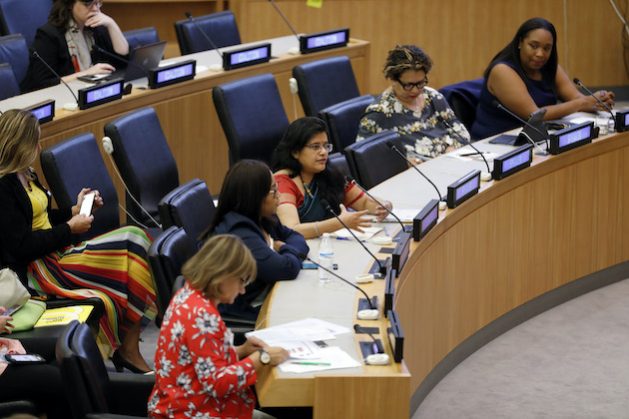Gender Sensitivity Key to Achieving Climate Justice — Global Issues
Toronto, May 27 (IPS) – While the climate crisis affects virtually every aspect of life, its impacts are not felt equally.
A person’s vulnerability to climate change varies depending on their position in society, such as socioeconomic status, dependence on natural resources, and capacity to respond to natural hazards. Since different genders often experience different social standings, gender has emerged as a key element to consider for effective climate planning and adaptation.
Angie Dazé, Gender Equality and Social Inclusion lead at the International Institute of Sustainable Development (IISD), says social norms linked to gender in their communities and households influence people’s different roles.
“Gender influences how people experience the impacts of climate change, and it also influences their capacity to respond,” Dazé told IPS in an interview. “Because people play different roles, they’re differently impacted by the same effects of climate change.”
While climate change experiences are context-specific and varied, a growing body of research suggests that women are more vulnerable to the impacts of climate change. The higher poverty level and lower socioeconomic power make recovery from natural disasters more difficult for women. UN figures also show that women and girls make up 80 percent of those displaced by climate change.
“Gender inequalities create barriers that can exacerbate people’s vulnerability to climate change. And this most often affects women and girls,” Dazé said.
Because social groups experience climate change differently, gender has become more central to the United Nations (UN) climate process and the international discourse around climate action.
Target 13.b of the UN Sustainable Development Goal (SDG) on climate actionrecognizes the gender-environment nexus. It states that focusing on women is key for increasing climate change planning and management capacity.
Key frameworks encouraging the integration of gender considerations for climate action, such as the enhanced Lima Work Programme on Gender and its Gender Action Plan, have also been established at recent UN Climate Change Conferences. Agreed upon at COP 25 in 2019, these frameworks promote gender mainstreaming for the parties and the integration of gender considerations throughout the UN Framework Convention on Climate Change (UNFCCC) work and processes.
Still, gender representation remains limited in climate decision-making spaces, and considerations of gender in national policy are inconsistent.
Despite men being just over half of the registered government delegates at UNFCCC plenary meetings from May to June 2021, according to a UNFCCC analysis, they spoke for 74 percent of the time. Attendance at COP gender-related events is also low.
On the national level, only 15 percent of environmental ministries are headed by women, and only a third of national energy frameworks contain considerations of gender. A study from the International Union for Conservation of Nature (IUCN) of 89 nationally determined contributions revealed that nearly a quarter have no references to gender.
Pointing to the harm of gender-blind approaches to climate policy, Christina Kwauk, a gender, education, and climate change specialist, told IPS, “the policies that we create could have unintended consequences that perpetuate structures of discrimination or inequality, or gender norms and harmful gender-based practices.
“Current policies or solutions or actions could exacerbate time poverty for women or exclude access to women. Maybe women might not have as much access to these different solutions because of existing gender norms.”
Kwauk credits the progress toward gender mainstreaming as significant but believes it has not reached the pace needed to see a significant impact.
Current gender-responsive climate policies, Kwauk explained, “are all pointing in the right direction. But the underlying systems of inequality and the underlying structures of inequality remain. And as long as those issues are still there, the policy, the discourse, these are good moves in the right direction, but they’re not enough. They’re not changing actual lived experiences the social norms, and the social barriers to participation.”
As an eco-feminist and climate change activist working on land access for women, Adenike Oladosu is familiar with the intersections of gender and the environment. In an interview with IPS, she stressed the need for countries to integrate gender throughout various sectors better and—pointing to her home country of Nigeria—the need for governments to legalize and implement their gender action plan throughout all sectors.
Oladosu believes that this action is paramount to improving the representation of women in global fora.
“When we see that gender is important in different sectors, it improves the representation of women in conferences because we are able to execute every action we take in a gender-sensitive manner,” Oladosu said. “It all has to start from individual countries, trying to improve gender sensitivity in their barriers, or trying to integrate gender-sensitive approaches in their various sectors.”
Empowering women can also help create new solutions to mitigate the climate crisis. Drawing upon her advocacy work, Oladosu emphasized that tapping into women’s indigenous knowledge as caretakers of the land and facilitating land access for women leads to new solutions for mitigating the climate crisis.
UN data shows that when women are provided with the same resources as men, they can increase agricultural yields by 20-30%, reducing hunger.
Overall, gender is key to consider—and women are paramount to involve—for a just and equitable fight against climate change.
“Women make up half of the population of the world,” Oladosu said. “So, if you take them away or leave them behind in solving the defining issue of our time, it definitely is going to affect the solutions that are brought up, or by now, we would have achieved climate justice.”
IPS UN Bureau Report
Follow @IPSNewsUNBureau
Follow IPS News UN Bureau on Instagram
© Inter Press Service (2022) — All Rights ReservedOriginal source: Inter Press Service
Check out our Latest News and Follow us at Facebook
Original Source







